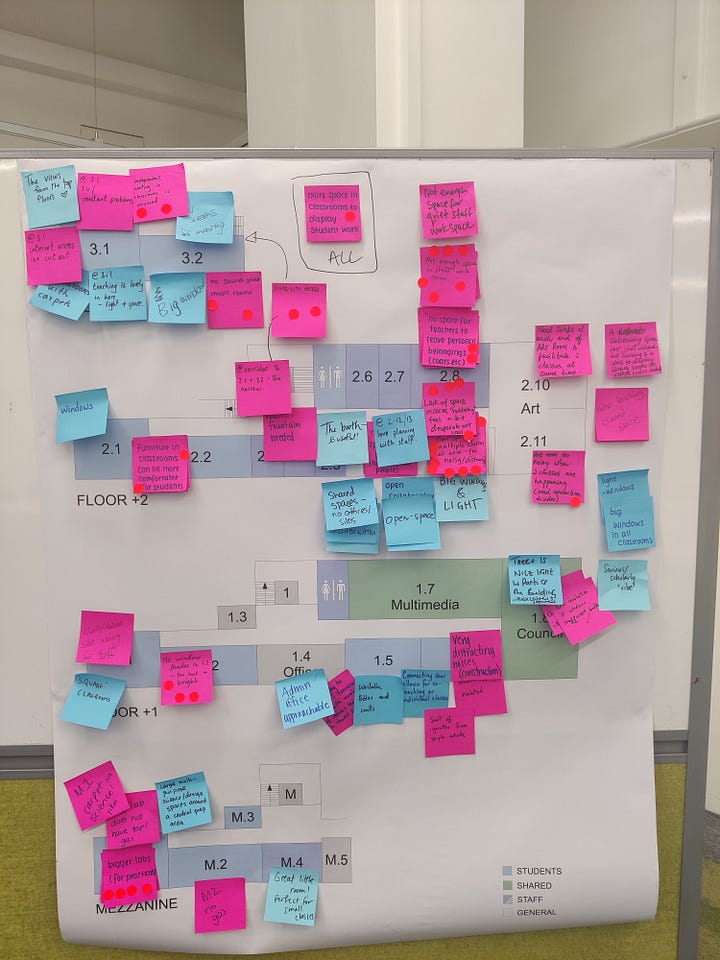An Effective Way to Identify Workplace Issues and Determine the Need for Renovation or Upgrade
A Step-by-Step Guide to Get a Clear Overview of the Pros and Cons of Your Workplace
It might have come to your ears that your workplace needs an upgrade, a renovation even. Is that necessary? Before jumping into conclusions too quickly, it might be necessary to do a little bit more research on this topic. Do we need an upgrade, do we need a renovation, how severe (read: how much will it cost) will this renovation be?
You can take a few steps back and analyse a little bit more. In this post I’ll explain you a very easy exercise. It originates from ‘The Sailboat’. People in facilitation and elsewhere might know it already!
The exercise you’ll be doing with the whole team plus decision making roles. If you have a big team then try to gather a mixture of people. You should be able to get a clear overview of the current issues in the building in order to solve them. You need decision making roles in order to take action or make decisions when the team gets stuck.
If you wish to see the video I made around this sailboat/ floorplan exercise, you can watch this video below where I explain the idea projected on a Music Festival.
The sailboat exercise
A sailboat exercise can be used for a variety of reasons. It can be used for finding problems and challenges when the problem doesn’t have a clear starting point, or the issues are too vague.
The sailboat as shown below has a sail and an anchor. The anchor represents “what is holding us back?” and the wind in the sails represents “what is moving us forward?”. In our case this will be the question we’ll be answering: What in this building is.. insert with the wind in the sails or the anchor. That’s it.
Draw the sailboat on a whiteboard with a marker. You will need two colours of sticky notes and you’ll also need sticky dots.
First ask the people to write down as much as positive things about the building. So what are features that they really like? Could be: the tranquility in space X, the big windows, the big open space outside during lunch time,.. Remind people that each positive aspect they should write down on individual sticky notes.
Ask the people to come forward and stick the positive notes on. By inviting everyone one by one, they can shortly read what they’ve written on the sticky note and stick it up. They don’t have to start explaining why or tell stories, it should go quick and easy.
Then we’ll move on to the next phase, the negative features of the building. This part of the exercise will always be anonymous, regarding the topic of the sailboat. People won’t have to go in front and say out loud what they have written. They will write on a different set of coloured sticky notes.
Here they will write negative parts of the building, such as: too little sockets, smelly bathrooms, bad lightning,.. When finished ask everyone to come to the front and stick the sticky notes on the whiteboard. Try to categorize them. Remove duplicates (same goes for the positive features).
Sweet!
The floorplan
A sailboat is often vague and people have to go really in their heads to memorize certain places in the building. In this exercise we’re going to transfer from the sailboat onto the floorplan.
Draw the floorplan, or print the floorplan on huge papers and hang them on. Ask the participants to transfer the positive features and the negative features onto the floorplan. It’s okay if not every sticky note gets transferred. They should stick the sticky note onto the zone where it fits. So for example: “the canteen is loud”, this sticky note should stick on the floorplan where it says ‘canteen’.


Give the participants extra time to go over the floorplan. They can write down positives and negatives as they go. General topics can be stuck onto the facade of the building. The reason why we do this is because this can generate extra things they didn’t think of earlier, but might still have a big effect.
Next up: voting. Provide a set of voting dots for everyone. Depending on the amount of people in your work session or the amount of sticky notes you’ll have to adjust the amount of voting dots. The participants will be voting on the negative sticky notes. The question they’ll have to keep in mind is: “What is holding me back most, personally?”. Depending on how many people with different kinds of jobs there are in the building you can adjust this question to a more broader audience. You’ll get a heat map of voting dots and you can easily see where the main physical error occurs in the building.
And that’s the exercise! You’ll now have a big messy overview of pros and cons of the building. In next week’s blogpost I’ll take you through the next steps in how to see how big your renovation or upgrade should be in order to keep productivity and well-being as high as possible in your workplace.
Thanks for reading!





